#pulp art 1934
Text

Saucy Movie Tales Dec 1935
Blaine = Norman Saunders
#golden age art#pulp magazine art#pulp art#pulp art 1934#Saucy Movie Tales#Norman Saunders art#byronrimbaud
7 notes
·
View notes
Text

Vintage Pulp - Thrilling Detective (Feb1934)
Better Publications
#Pulp#Thrilling Detective#Robots#Science Fiction#Crime#Johnston McCulley#Pulp Art#Pulp Illustration#Art#Better Publications#CMK Scanlon#Illustration#1934#1930s#30s
100 notes
·
View notes
Text

Mystery, June 1934
Cover by Charles De Feo
58 notes
·
View notes
Text
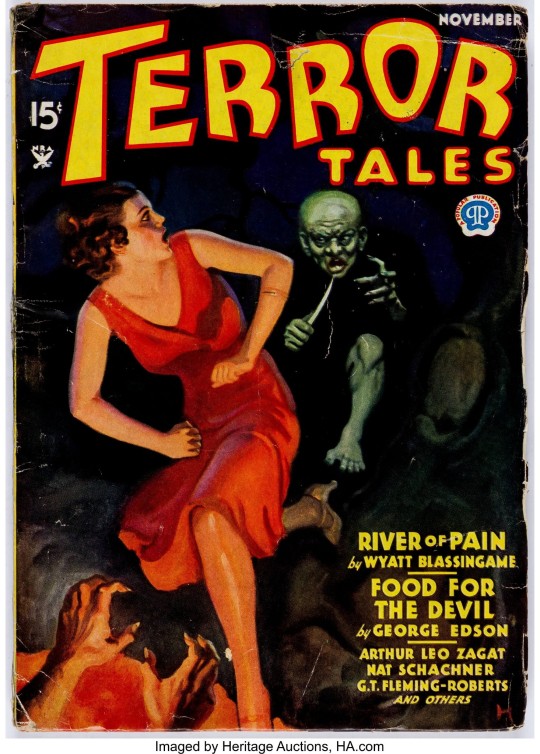
Vintage Pulp - Terror Tales (Nov1934) (Popular Publications)
#Pulp#Terror Tales#Horror#Arthur Leo Zagat#GT Fleming-Roberts#Vintage#Art#Pulp Art#Pulp Illustration#Popular Publications#Popular#1934#1930s#30s
14 notes
·
View notes
Text
Advice on writing from writers
1.
I can only say that I kept reading and reading and your book never fucking began. You just kept telling the reader how extraordinary your leading character was. You obviously have talent, but what is the good of it if most of your readers (as I suspect) will either read you uncomfortably or stop altogether. This won’t be because they are not necessarily up to the mark but because of the glittering vanity with which you put your sentences together. I would never tell you that you don’t have talent. You are in a peculiar position of having too much felicity with words and, therefore, do not seem ready as yet, to get into the hard and often dreary literary mechanics of writing novels and editing them. These are harsh words, but you are bright enough and I would like to encourage you to take the art of novel writing more seriously than your enjoyment of yourself.
Norman Mailer
Letter to John Kriegsman
21st July 2006
(Source: Selected Letters of Norman Mailer, edited by J. Michael Lennon
2.
Your vivid, exciting companionship in the office must not be your audience, you must find your own quiet centre of life, and write from that to the world that holds offices, and all society, all Bohemia; the city, the country—in short, you must write to the human heart, the great consciousness that all humanity goes to make up. Otherwise what might be strength in a writer is only crudeness, and what might be insight is only observation; sentiment falls to sentimentality—you can write about life, but never write life itself. And to write and work on this level, we must live on it—we must at least recognize it and defer to it at every step. We must be ourselves, but we must be our best selves.
Sarah Orne Jewett
Letter to Willa Cather
13th December 1908
(Source: The Selected Letters of Willa Cather, edited by Andrew Jewell)
3.
A long time ago when I was writing for pulps I put into a story a line like “he got out of the car and walked across the sun-drenched sidewalk until the shadow of the awning over the entrance fell across his face like the touch of cool water.” They took it out when they published the story. Their readers didn’t appreciate this sort of thing: just held up the action. And I set out to prove them wrong. My theory was that they just thought they cared nothing about anything but the action; that really, although they didn’t know it, they cared very little about the action. The things they really cared about, and that I cared about, were the creation of emotion through dialog and description; the things they remembered, that haunted them, were not for example that a man got killed, but that in the moment of his death he was trying to pick a paper clip up off the polished surface of a desk, and it kept slipping away from him, so that there was a look of strain on his face and his mouth was half open in a kind of tormented grin, and the last thing in the world he thought about was death. He didn't even hear death knock on the door. That damn little paper clip kept slipping away from his fingers and he just couldn't push it to the edge of the desk and catch it as it fell.
Raymond Chandler
Letter to Frederick Lewis Allen
7th May 1948
(Source: Selected Letters of Raymond Chandler, edited by Frank McShane)
4.
For Christ sake write and don’t worry about what the boys will say nor whether it will be a masterpiece nor what. I write one page of masterpiece to ninety one pages of shit. I try to put the shit in the wastebasket.
Ernest Hemingway
Letter to F. Scott Fitzgerald
28th May 1934
(Source: Ernest Hemingway: Selected Letters 1917-1961, edited by Carlos Baker)
5.
For a writer, a feeling for words—for language—must be the principal thing—the central endowment. Without such a feeling it is useless to apply oneself to the hard, hard tasks which face the writer, throughout his or her career. You have this feeling for language, but you have not developed it very far. For you do not write, as we say, “in form.” You write free verse. At seventeen, if you are to go on writing poetry, you must not only begin to acquaint yourself with the effects of formal verse, but you must begin to use these effects. You can begin by imitating this poet or that as long as you admit that you are imitating. You must begin to practise—as a pianist practises (only you are practising creatively, of course-not merely performing). You show a slight tendency toward form, in these poems of your manuscript, but not consistently. I should say, from present evidence, that you might very well turn out to be a writer of prose—a novelist, say, if you have any storytelling ability.
So try writing all sorts of things! And look into some textbooks on prosody. Poetry Handbook, by Babette Deutsch (Funk and Wagnall) is a valuable, recent such book, that has received high praise from many people, including myself. Any book store will order it for you.
Write and read! Read and write! Those are the two rules.
Louise Bogan
Letter to an aspiring poet
6th April 1984
(Source: What the Woman Lived: Selected Letters of Louise Bogan, 1920-1970, edited by Ruth Limmer)
6.
Never use jargon words like reconceptualize, demassification, attitudinally, judgmentally. They are hallmarks of a pretentious ass.
David Ogilvy
Memo to his colleagues
17th September 1982
(Source: The Unpublished David Ogilvy, edited by Joel Raphaelson)
7.
Nobody ever became a writer just by wanting to be one. If you have anything to say, anything you feel nobody has ever said before, you have got to feel it so desperately that you will find some way to say it that nobody has ever found before, so that the thing you have to say and the way of saying it blend as one matter—as indissolubly as if they were conceived together.
Let me preach again for one moment: I mean that what you have felt and thought will by itself invent a new style so that when people talk about style they are always a little astonished at the newness of it, because they think that is only style that they are talking about, when what they are talking about is the attempt to express a new idea with such force that it will have the originality of the thought.
F. Scott Fitzgerald
Letter to his daughter
20th October 1936
(Source: A Life in Letters, edited by Matthew J. Bruccoli)
8.
You describe a sweet place, but your descriptions are often more minute than will be liked. You give too many particulars of right hand and left.
Jane Austen
Letter to her niece
9th September 1814
(Source: Jane Austen’s Letters, edited by Dierdre Le Faye)
9.
There is no trick to it. If you like to write and want to write, you write, no matter where you are or what else you are doing or whether anyone pays any heed. I must have written half a million words (mostly in my journal) before I had anything published, save for a couple of short items in St. Nicholas. If you want to write about feelings, about the end of summer, about growing, write about it. A great deal of writing is not “plotted”—most of my essays have no plot structure, they are a ramble in the woods, or a ramble in the basement of my mind. You ask, “Who cares?” Everybody cares. You say, “It’s been written before.” Everything has been written before.
E. B. White
Letter to Miss R.
15th September 1973
(Source: Letters of E. B. White, edited by Dorothy Lobrano Guth)
10.
When authors write best, or, at least, when they write most fluently, an influence seems to waken in them which becomes their master—which will have its way —putting out of view all behests but its own, dictating certain words, and insisting on their being used, whether vehement or measured in their nature, new moulding characters, giving unthought of turns to incidents, rejecting carefully elaborated old ideas, and suddenly creating and adopting new ones.
Charlotte Brontë
Letter to George Henry Lewes
12th January 1848
(Source: The Brontës: Life and Letters, edited by Clement Shorter)
11.
1. Abandon the idea that you are ever going to finish. Lose track of the 400 pages and write just one page for each day, it helps. Then when it gets finished, you are always surprised.
2. Write freely and as rapidly as possible and throw the whole thing on paper. Never correct or rewrite until the whole thing is down. Rewrite in process is usually found to be an excuse for not going on. It also interferes with flow and rhythm which can only come from a kind of unconscious association with the material.
3. Forget your generalized audience. In the first place, the nameless, faceless audience will scare you to death and in the second place, unlike the theatre, it doesn't exist. In writing, your audience is one single reader. I have found that sometimes it helps to pick out one person—a real person you know, or an imagined person and write to that one.
4. If a scene or a section gets the better of you and you still think you want it—bypass it and go on. When you have finished the whole you can come back to it and then you may find that the reason it gave trouble is because it didn't belong there.
5. Beware of a scene that becomes too dear to you, dearer than the rest. It will usually be found that it is out of drawing.
6. If you are using dialogue—say it aloud as you write it. Only then will it have the sound of speech.
John Steinbeck
Letter to Robert Wallsten
14th February 1962
(Source: Steinbeck: A Life in Letters, edited by Elaine Steinbeck and Robert Wallsten)
12.
Keep writing and profit by criticism. Mind grammar, spelling, and punctuation, use short words, and express as briefly as you can your meaning. Young people use too many adjectives and try to “write fine.” The strongest, simplest words are best, and no foreign ones if it can be helped.
Write, and print if you can; if not, still write, and improve as you go on. Read the best books, and they will improve your style. See and hear good speakers and wise people, and learn of them. Work for twenty years, and then you may some day find that you have a style and place of your own, and can command good pay for the same things no one would take when you were unknown.
Louisa May Alcott
Letter to Mr. J. P. True
24th October (year unknown)
(Source: Louisa May Alcott: Her life, letters, and journals, edited by Edna D. Cheney)
13.
1. Always try to use the language so as to make quite clear what you mean and make sure your sentence couldn’t mean anything else.
2. Always prefer the plain direct word to the long, vague one. Don’t implement promises, but keep them.
3. Never use abstract nouns when concrete ones will do. If you mean “More people died” don’t say “Mortality rose.”
4. In writing. Don’t use adjectives which merely tell us how you want us to feel about the thing you are describing. I mean, instead of telling us a thing was “terrible,” describe it so that we’ll be terrified. Don’t say it was “delightful”; make us say “delightful” when we’ve read the description. You see, all those words (horrifying, wonderful, hideous, exquisite) are only like saying to your readers, “Please will you do my job for me.”
5. Don’t use words too big for the subject. Don’t say “infinitely” when you mean “very”; otherwise you’ll have no word left when you want to talk about something really infinite.
C. S. Lewis
Letter to Joan
26th June 1956
(Source: Letters of C. S. Lewis, edited by W. H. Lewis)
14.
Do be careful of your adjectives – do try and be terse, there is so much more force in a rapid style that will not be hampered by superfluous details. Just look at your piece and see how many three lined sentences could be comfortably expressed in one line. . . try to be terse and in some way original – the world abounds with new similes and metaphors.
D. H. Lawrence
Letter to Louise Burrows
September 1906
Source: The Letters of D. H. Lawrence, Vol.1, edited by James T. Boulton)
15.
[F]rom its exposition through its agon, to its unravelling a plot should be a living organism, and its central intelligence, the voice which manipulates and dialectically arouses, fulfils and frustrates my expectations, and which ultimately rewards me with a perception into the meaning of all the sound and fury that makes up a story, is one into whose hands I have surrendered my own intelligence, imagination, and sense of life. And when that central intelligence assumes such responsibility and authority but fails to deliver, he violates my trust and embarrasses the author for whom he acts as surrogate.
Ralph Ellison
Letter to Horace Porter
29th February 1986
(Source: The Selected Letters of Ralph Ellison, edited by John F. Callahan & Marc Conner)
16.
Here’s an assignment for tonight, and I hope Ms. Lockwood will flunk you if you don’t do it: Write a six line poem, about anything, but rhymed. No fair tennis without a net. Make it as good as you possibly can. But don’t tell anybody what you’re doing. Don’t show it or recite it to anybody, not even your girlfriend or parents or whatever, or Ms. Lockwood. OK?
Tear it up into teeny-weeny pieces, and discard them into widely separated trash receptacles. You will find that you have already been gloriously rewarded for your poem. You have experienced becoming, learned a lot more about what’s inside you, and you have made your soul grow.
Kurt Vonnegut
Letter to the students of Xavier High School
5th November 2006
(Source: More Letters of Note)
BONUS
This sentence has five words. Here are five more words. Five-word sentences are fine. But several together become monotonous. Listen to what is happening. The writing is getting boring. The sound of it drones. It’s like a stuck record. The ear demands some variety.
Now listen. I vary the sentence length, and I create music. Music. The writing sings. It has a pleasant rhythm, a lilt, a harmony. I use short sentences. And I use sentences of medium length. And sometimes, when I am certain the reader is rested, I will engage him with a sentence of considerable length, a sentence that burns with energy and builds with all the impetus of a crescendo, the roll of the drums, the crash of the cymbals—sounds that say listen to this, it is important.
Gary Provost
100 Ways to Improve Your Writing
1985
(Source)
3 notes
·
View notes
Photo
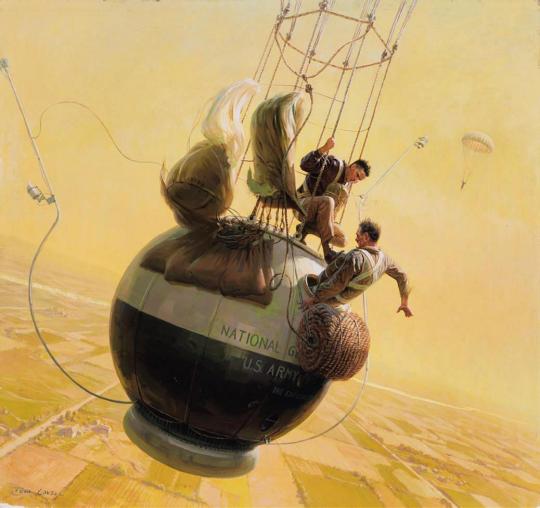
MWW Artwork of the Day (11/15/22)
Tom Lovell (American, 1909-1997)
Balloonists Struggle to Escape a Doomed Gondola (Sept. 1934)
Oil on joined board, 58.4 x 62.2 cm.
Private Collection
On July 28, 1934, the Explorer I manned by Major William E. Kepner, Captain Albert W. Stevens, and Captain Orvil A. Anderson, attempted to set the new highest-altitude record, but came short of this goal when the gas bag exploded, forcing the three adventurers to "leap for their lives by parachute." This work here illustrates this harrowing feat and was both the cover of the 75th anniversary issue of National Geographic magazine as well as a feature in the same issue. It illustrates the balloon after its crash landing of the first attempt, surrounded by the survivors. The artist, Tom Lovell, was a creator of pulp fiction magazine covers and illustrations, and of visual art of the American West. He once said of himself: "I consider myself a storyteller with a brush. I try to place myself back in imagined situations that would make interesting and appealing pictures. I am intent on producing paintings that relate to the human experience."
2 notes
·
View notes
Text



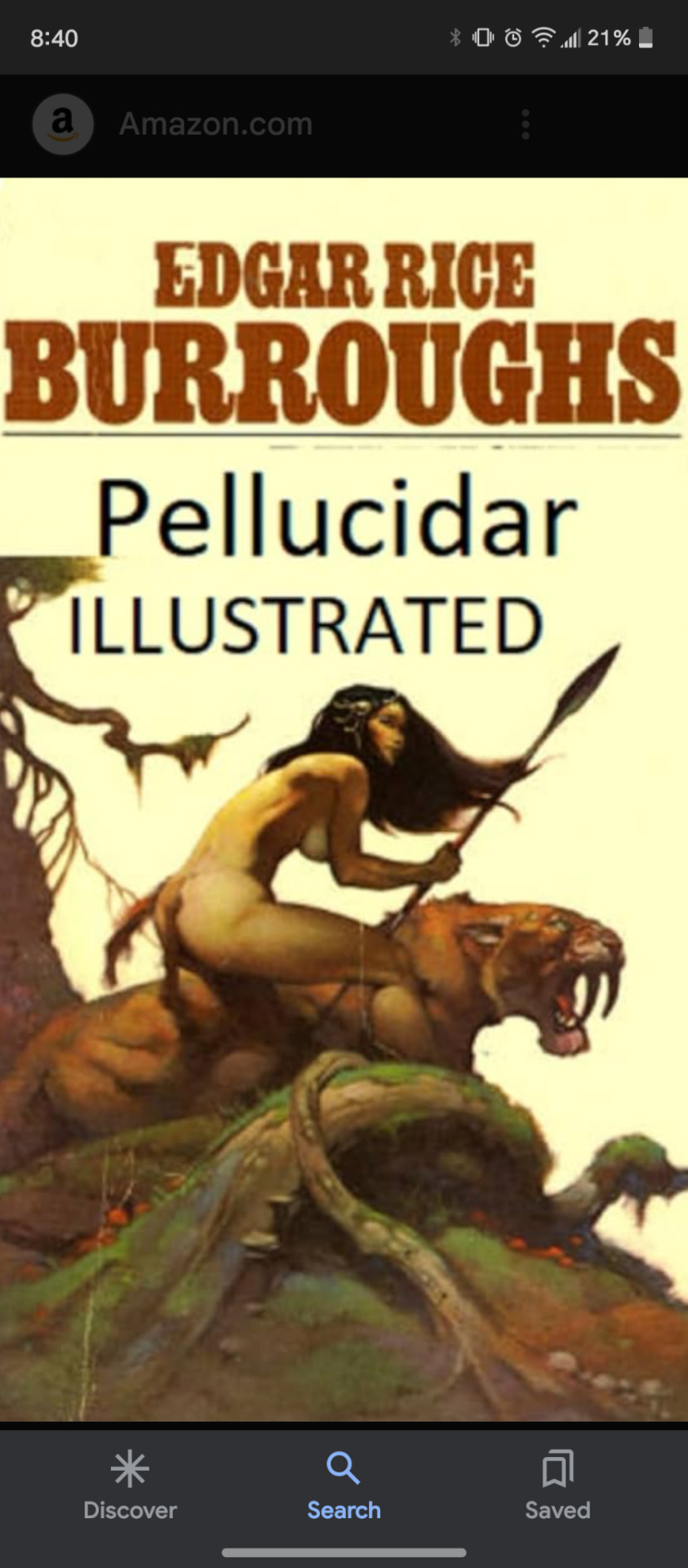

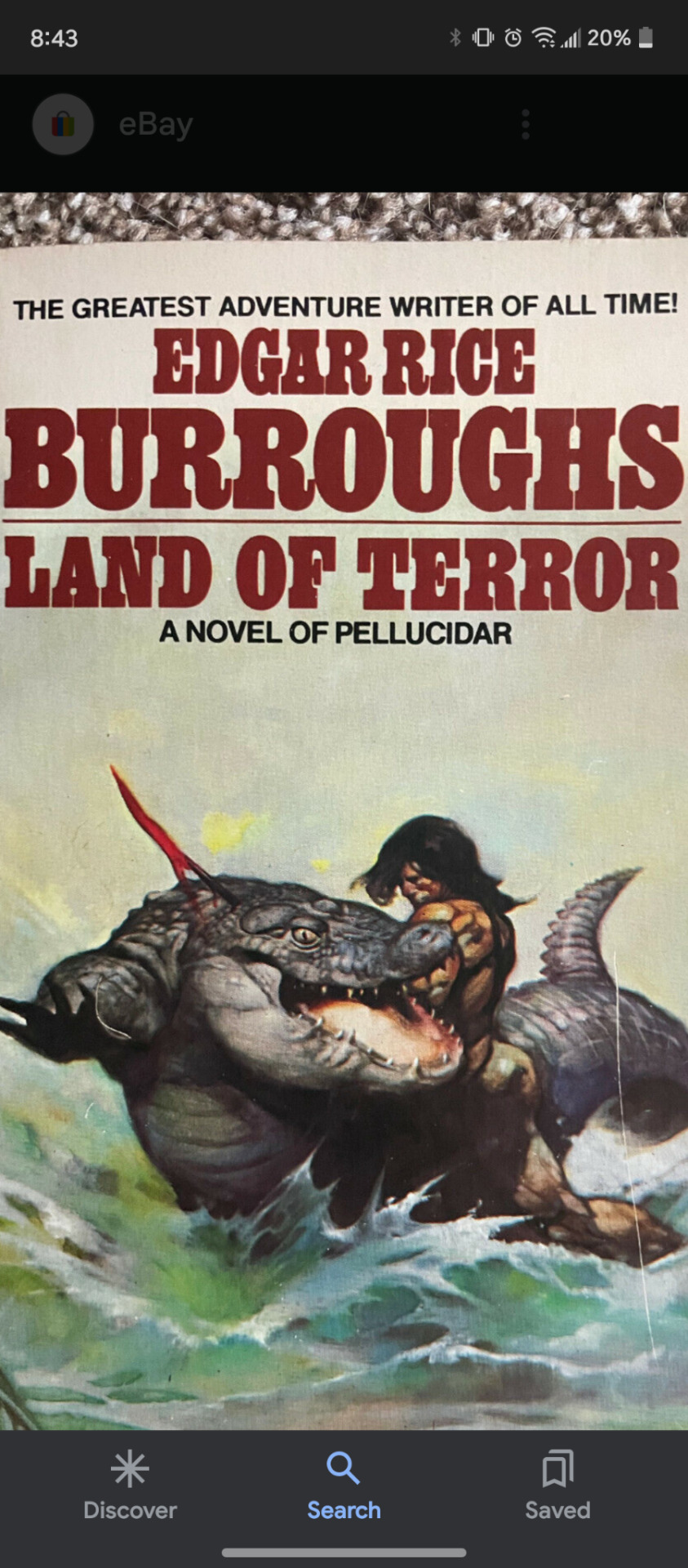
Pics:
1 & 2. Photos of Edgar Rice Burroughs the creator of Tarzan, John Carter & so many other heroes, villains & vivid settings...
3. Map of the Inner World of Pellucidar. The name that comes from the word pellucid, for something that's "transparently clear" - as befits a 'place' under continual 'sun' light.
4. Cover for a special edition of the novel "Pellucidar." Back when artists helped you view the story in your mind!
5 & 6. Covers for 2 of the books in this 7 novel series & of interest to us...
1906: The Earth (is) Not Hollow.
Edgar R. Burroughs was an American writer who's best known for his hero Tarzan. He had a prolific output in the sci-fi, fantasy & adventure genres.
Burroughs' works sold 30 million copies during his lifetime! And, he was an early pioneer of the crossover event - having Tarzan visit his fantasy series, "Pellucidar".
Plots: These 7 Hollow Earth novels begin with a giant mechanical driller taking our heroes underground - to look for mineral deposits.
Instead, the "Iron Mole" discovers an Inner World some 500 miles below the Earth's crust!
A place lit up by a the molten core acting like a tiny 'sun.' So, there's no 'measurable' time there - it's always 'now'...
Stranger still, the land curves upward! As if everything's inside of a bowl.
More importantly, it's a place that's inhabited by ancient animals & enslaved humans!!
But, worse, every being in Pellucidar is trying to survive - by killing & eating each other!!
Mahars, winged reptilian overlords - with hypnotic powers, run a slave society & like to snack on people!
The series takes readers across many savage lands & seas - with our heroes battling their way thruout a vast Inner World...
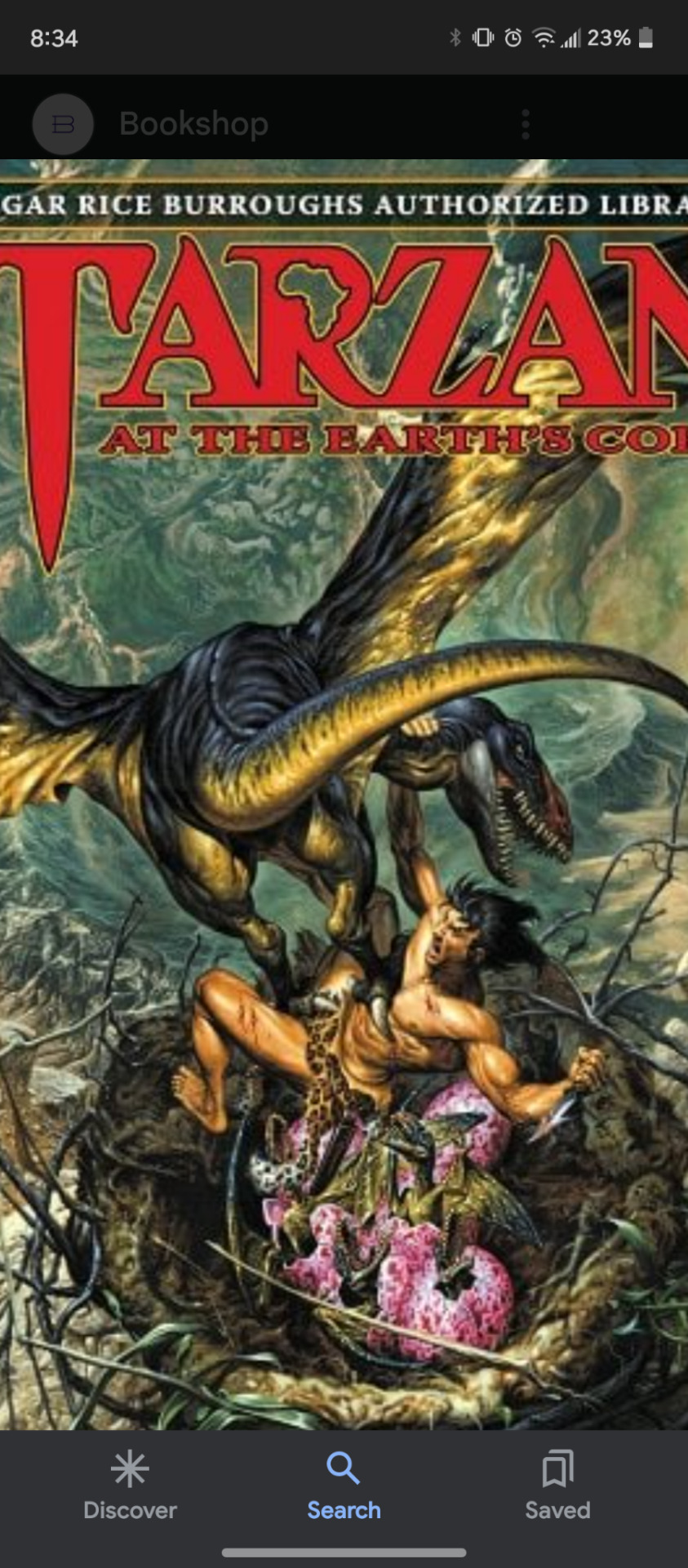



Pics:
1 & 2. Great cover & card art(?) for "Tarzan At the Earth's Core." This was a landmark crossover between 2 of Burroughs' novel series. A rare event in those bygone days.
3 & 4. Inside art from a comic book adaptation - with, it seems, art from the great Thomas Yeates(?)...
Criticisms: Usually, such 'colonial' authors don't fare well with modern readers. Their legacies become tainted due to the writers' white supremacist sympathies.
Figures like: Rudyard Kipling, Joseph Conrad & yes, even Lovecraft, all have repugnant personal ideas behind their works.
The same can be said of Burroughs. He's a man who's famous for creating an African jungle hero. Yet, the writer never visited Africa himself!
Burroughs was actually 'inspired' by the pulps he read as he struggled to sell pencil sharpeners...
ERB, "If (pulp writers) were paid for writing such... rot, I could write stories just as rotten..."
Since then, readers have argued that Burroughs exceeded the low bar he set for himself!
Burroughs was also smart enough to make business brands & franchises out of his works.
The skeptics of the time, chided him for 'diluting' his writings.
They were wrong.
To date, there's been over 50 films made out of his Tarzan character alone!
And, many of his literary inventions have received various types of multi- media adaptation.
According to the NY Times, "Before Tarzan, nobody understood... how marketable a (such a commodity) could be."
Weird Factoid: In 1929, the 1st Tarzan book was removed from the Los Angeles Public Library - supposedly because Tarzan & Jane were "living in sin!"
Then, in 1934, Germany got into the same act!! The Berlin Film Control Board banned all the Tarzan books for being "dangerous to Nazi 'principles' of race... & offensive to Nazi ideals (like) womanly dignity!"
(Why's my sense of irony tingling?!)
Life: Burroughs was a patriotic man who attended the Michigan Military Academy - both, as student & as a geology teacher.
At the beginning of WW1, Burroughs tried to attend West Point, get into 'Teddy' Roosevelt's Rough Riders or wanted to join the Chinese Army - as a mercenary!!
But, he was denied entry to all...
So, Borroughs enlisted in the U.S. Army - & got sent to Arizona! There, he was Captain of the U.S. Reserves & would rise to the rank of Major.
Burroughs also wrote patriotic articles & worked pro-American themes into his short stories & novels.
His military training had instilled the idea of honor between warriors in Burroughs. This morality came to play a role in his heroes' development.
Burroughs also hated Communism. He planned to write a novel of a future where Bolshevism ruled the world - just for the Army!
But, this idea was nixed in the bud.
After the war, this plot germ became his novel "The Moon Maid."
Later in life, Burroughs moved to Hawaii, where he heard the surprise Japanese attack on Pearl Harbor!!
Unable to join the fight, he became the oldest war correspondent in U.S. history...
After WW2, Burroughs suffered from several health problems. He was supposedly reading a comic book when he died - of a heart attack.
0 notes
Text
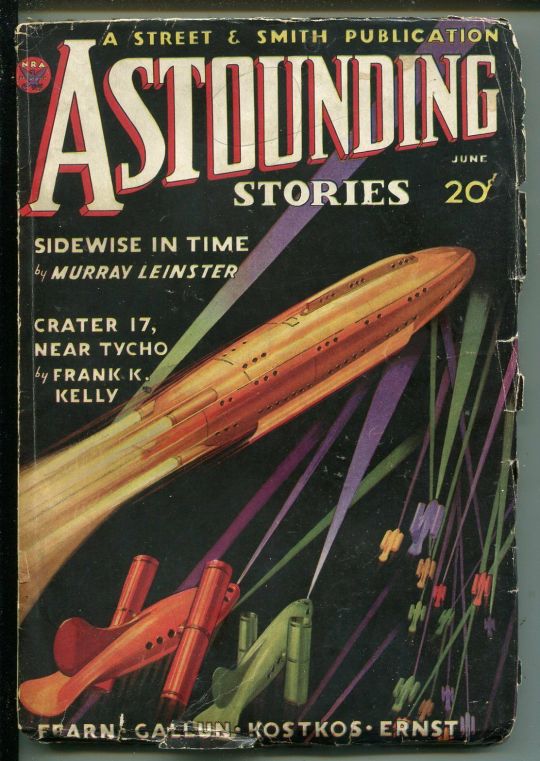
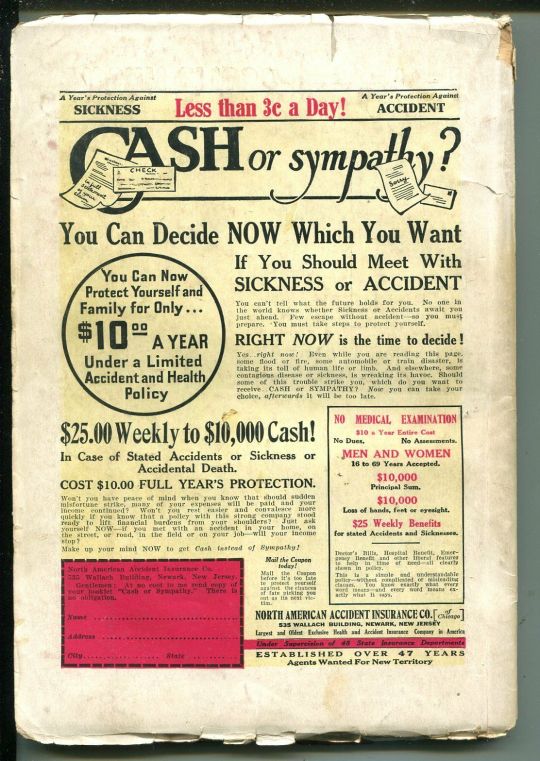
Vintage Pulp - Astonishing Stories (June1934)
#Pulp#Magazines#Astounding Stories#Science Fiction#Rockets#Art Deco#Vintage#Art#Illustration#Design#Ads#Advertising#1934#1930s#30s#Pulp Art#Pulp Illustration#Murray Leinster
25 notes
·
View notes
Photo

Blaze of Glory - art by Rafael DeSoto (1934)
#rafael desoto#blaze of glory#pulp art#black book detective magazine#cover art#pulp artist#1930s#1934
55 notes
·
View notes
Video
<strong>The Stick-Up, Complete Detective Novel Magazine, July 1934, cover by Harry L. Parkhurst <a href="https://www.flickr.com/photos/randar/">by Tom Simpson</a></strong>
#Harry L. Parkhurst#h. l. parkhurst#harry lemon parkhurst#parkhurst#illustration#painting#art#vintage#pulp#pulp art#woman#man#The Stick-Up#pulp magazine cover#Complete Detective Novel Magazine#1934#cover#revolver#fashion#1930s#magazine
18 notes
·
View notes
Text
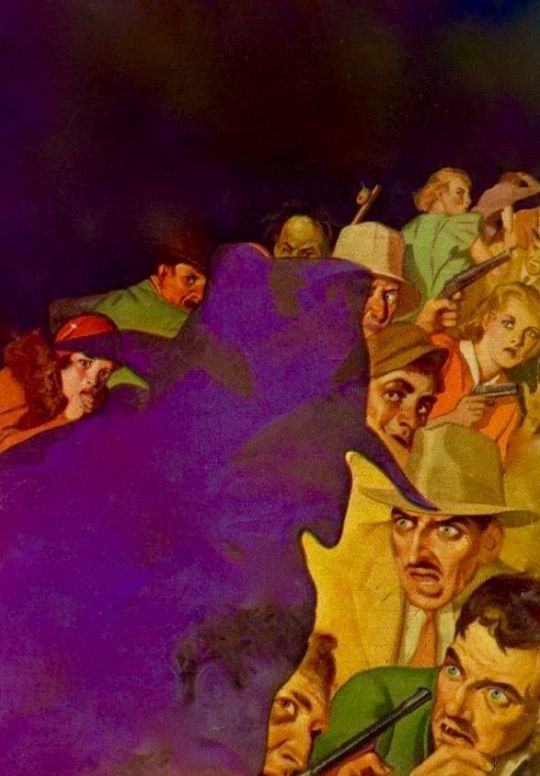
The Shadow Oct 15 1934
George Rozen
5 notes
·
View notes
Text
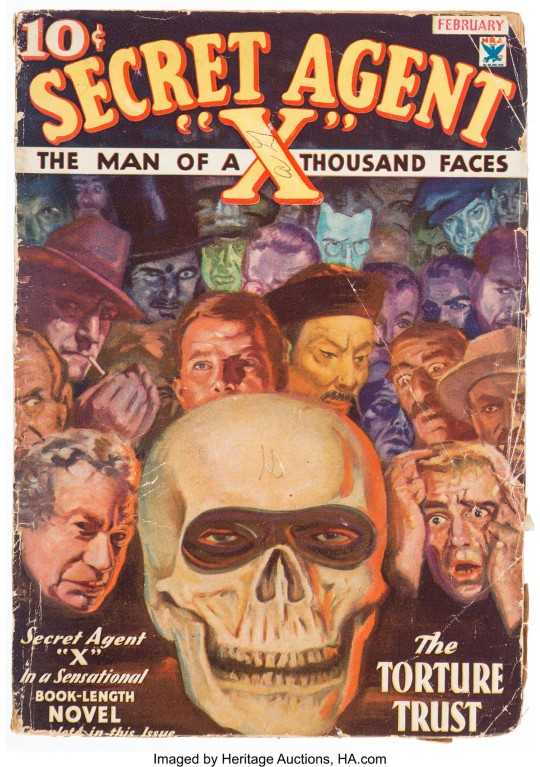
Vintage Pulp - Secret Agent X (Feb1934) (Ace)
28 notes
·
View notes
Photo
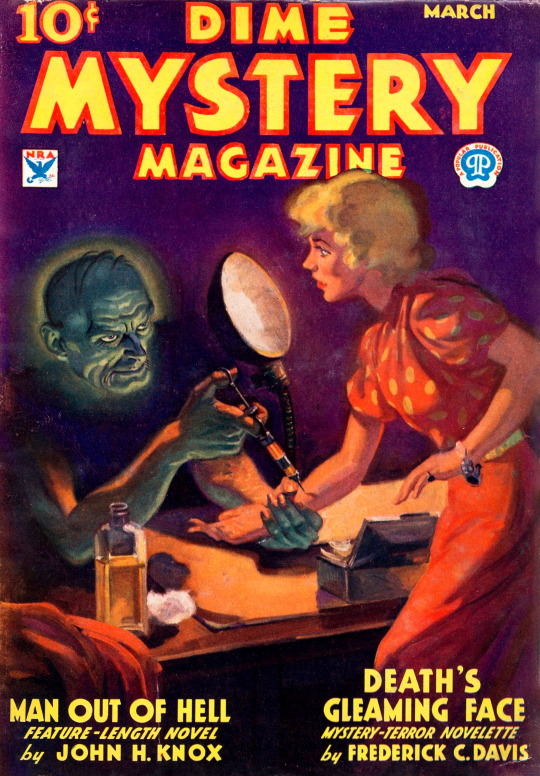
Dime Mystery Magazine, March 1934
38 notes
·
View notes
Photo
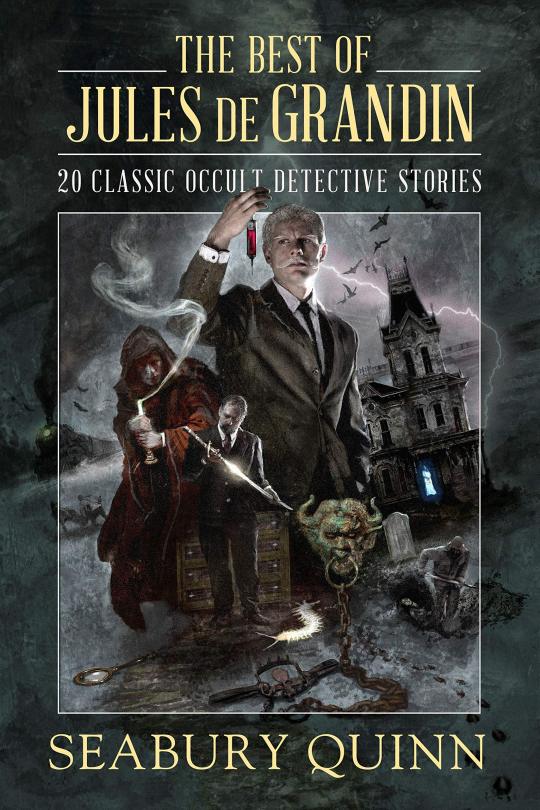
The Best of Jules de Grandin: 20 Classic Occult Detective Stories, by Seabury Quinn, edited by George Vanderburgh, Night Shade Books, 2020. Cover art by Donato Giancola, info: skyhorsepublishing.com.
A collection of the 20 greatest tales of Jules de Grandin, the supernatural detective made famous in the classic pulp magazine Weird Tales. Today the names of H.P. Lovecraft, Robert E. Howard, August Derleth, and Clark Ashton Smith, all regular contributors to the pulp magazine Weird Tales during the first half of the twentieth century, are recognizable even to casual readers of the bizarre and fantastic. And yet despite being more popular than them all during the golden era of genre pulp fiction, there is another author whose name and work have fallen into obscurity: Seabury Quinn. Quinn’s short stories were featured in well more than half of Weird Tales’s original publication run. His most famous character, the supernatural French detective Dr. Jules de Grandin, investigated cases involving monsters, devil worshippers, serial killers, and spirits from beyond the grave, often set in the small town of Harrisonville, New Jersey. In de Grandin there are familiar shades of both Arthur Conan Doyle’s Sherlock Holmes and Agatha Christie’s Hercule Poirot, and alongside his assistant, Dr. Samuel Trowbridge, de Grandin’s knack for solving mysteries—and his outbursts of peculiar French-isms (grand Dieu!)—captivated readers for nearly three decades. The Best of Jules de Grandin, edited by George Vanderburgh, presents twenty of the greatest published works featuring the supernatural detective. Presented in chronological order with stories from the 1920s through the 1940s, this collection contains the most incredible of Jules de Grandin's many awe-inspiring adventures.
Contents:
Introduction by George A. Vanderburgh and Robert E. Weinberg
The Isle of Missing Ships (Weird Tales, February 1926)
The House of Horror (Weird Tales, July 1926)
The Great God Pan (Weird Tales, October 1926)
Restless Souls (Weird Tales, October 1928)
The Black Master (Weird Tales, January 1929*)
The Devil’s Rosary (Weird Tales, April 1929†)
The House without a Mirror (Weird Tales, November 1929)
Stealthy Death (Weird Tales, November 1930)
Satan’s Stepson (Weird Tales, September 1931)
The Bleeding Mummy (Weird Tales, November 1932)
The Thing in the Fog (Weird Tales, March 1933‡)
The Hand of Glory (Weird Tales, July 1933‡)
The Mansion of Unholy Magic (Weird Tales, October 1933)
Red Gauntlets of Czerni (Weird Tales, December 1933‡)
The Jest of Warburg Tantavul (Weird Tales, September 1934)
Hands of the Dead (Weird Tales, January 1935)
Witch-House (Weird Tales, November 1936‡)
Suicide Chapel (Weird Tales, June 1938‡)
The House Where Time Stood Still (Weird Tales, March 1939)
The Green God’s Ring (Weird Tales, January 1945)
*Cover by Curtis C. Senf
†Cover by Hugh Rankin
‡Cover by Margaret Brundage
#book#collection#seabury quinn#jules de grandin#weird fiction#supernatural fiction#occult detective fiction#supernatural detective stories
13 notes
·
View notes
Photo
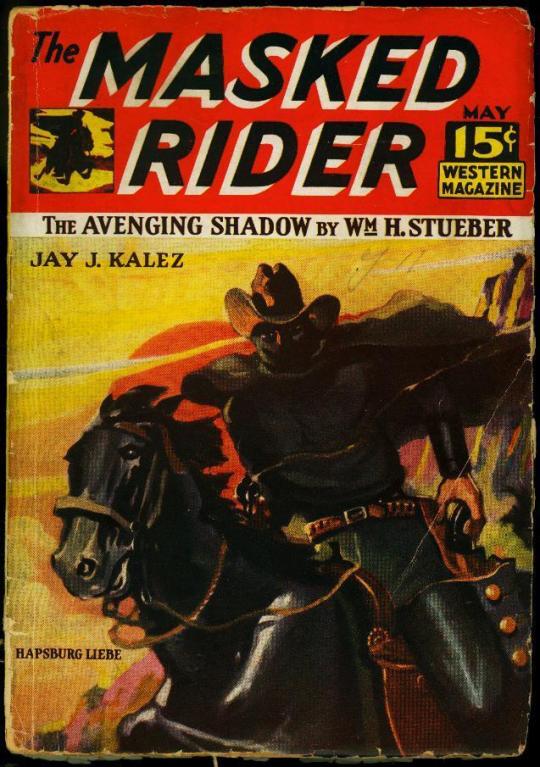
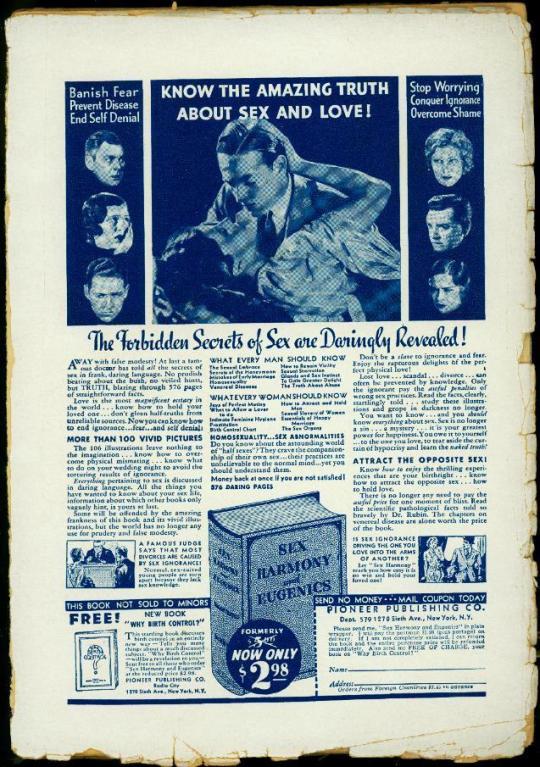
Vintage Pulp - The Masked Rider (May1934)
#Vintage#Art#Illustration#Design#Pulp#Magazines#The Masked Rider#Masked Rider#Westerns#Ads#Advertising#1934#1930s#30s
36 notes
·
View notes
